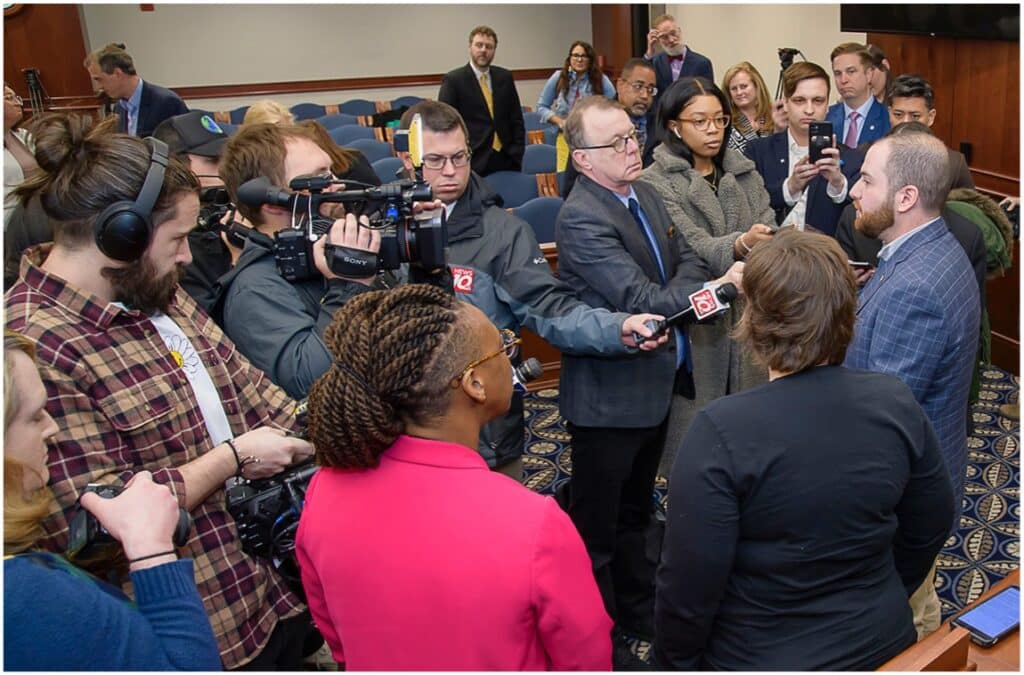This survey was conducted by the Media Insight Project, an initiative of the American Press Institute (API) and The Associated Press-NORC Center for Public Affairs Research. The survey was funded by API. Staff from API, NORC at the University of Chicago, and AP collaborated on all aspects of the study.
Data were collected using the AmeriSpeak Omnibus®, a bi-monthly multi-client survey using NORC’s probability-based panel designed to be representative of the U.S. household population. The survey was part of a larger study that included questions about other topics not included in this report. During the initial recruitment phase of the panel, randomly selected U.S. households were sampled with a known, non-zero probability of selection from the NORC National Sample Frame and then contacted by U.S. mail, email, telephone, and field interviewers (face-to-face). The panel provides sample coverage of approximately 97 percent of the U.S. household population. Those excluded from the sample include people with P.O. Box only addresses, some addresses not listed in the USPS Delivery Sequence File, and some newly constructed dwellings.
Interviews for this survey were conducted between March 21 through 25, 2024, with adults aged 18 and over representing the 50 states and the District of Columbia. Panel members were randomly drawn from AmeriSpeak, and 2,468 completed the survey — 2,327 via the web and 141 by telephone. Panel members were invited by email or by phone from an NORC telephone interviewer. For purposes of analysis, the survey included oversamples of Black adults (n=591), Asian American, Native Hawaiian and Pacific Islander (AAPI) adults (n=449), Hispanic adults (n=535), and rural residents (n=322). Interviews were conducted in English. Respondents were offered a small monetary incentive for completing the survey. The final stage completion rate is 16.3 percent, the weighted household panel response rate is 22.3 percent, and the weighted household panel retention rate is 78.9 percent, for a cumulative response rate of 2.9 percent.
The overall margin of sampling error is +/- 2.9 percentage points at the 95 percent confidence level, including the design effect. The margin of sampling error may be higher for subgroups. For example, the margin of sampling error is +/- 3.9 percentage points for white adults, +/- 5.5 percentage points for Black adults, +/-6.5 percentage points for Hispanic adults, and +/-7.5 percentage points for AAPI adults.
Sampling error is only one of many potential sources of error and there may be other unmeasured error in this or any other survey.
Quality assurance checks were conducted to ensure data quality. In total, 144 interviews were removed for nonresponse to at least 50% of the questions asked of them, for completing the survey in less than one-third the median interview time for the full sample, or for straight-lining all grid questions asked of them. These interviews were excluded from the data file prior to weighting.
Once the sample has been selected and fielded, and all the study data have been collected and made final, a poststratification process is used to adjust for any survey nonresponse as well as any noncoverage or under and oversampling resulting from the study specific sample design.
Poststratification variables included age, gender, census division, race/ethnicity, and education. Weighting variables were obtained from the 2023 Current Population Survey. The weighted data reflect the U.S. population of adults age 18 and over.
Download the topline results or the full report PDF.
Additional information on the AmeriSpeak Panel methodology is available at: https://amerispeak.norc.org/about-amerispeak/Pages/Panel-Design.aspx.
For more information, email info@apnorc.org.
About the Media Insight Project
The Media Insight Project is a collaboration between the American Press Institute and The AP-NORC Center for Public Affairs Research with the objective of conducting high-quality, innovative research meant to inform the news industry and the public about various important issues facing journalism and the news business. The Media Insight Project brings together the expertise of both organizations and their respective partners, and involves collaborations among key staff at the American Press Institute, NORC at the University of Chicago, and The Associated Press. http://www.mediainsight.org/
About the American Press Institute
API supports local and community-based media through research, programs and products that foster healthy, responsive and resilient news organizations. API envisions an inclusive democracy and society, where communities have the news and information they need to make decisions and thrive. API is a national 501(c)3 nonprofit educational organization affiliated with the News/Media Alliance. http://www.pressinstitute.org
About the Associated Press-NORC Center for Public Affairs Research
The AP-NORC Center for Public Affairs Research taps into the power of social science research and the highest-quality journalism to bring key information to people across the nation and throughout the world.
- The Associated Press (AP) is an independent global news organization dedicated to factual reporting. Founded in 1846, AP today remains the most trusted source of fast, accurate, unbiased news in all formats and the essential provider of the technology and services vital to the news business. More than half the world’s population sees AP journalism every day. ap.org
- NORC at the University of Chicago is one of the oldest objective and nonpartisan research institutions in the world. norc.org
The two organizations have established The AP-NORC Center for Public Affairs Research to conduct, analyze, and distribute social science research in the public interest on newsworthy topics, and to use the power of journalism to tell the stories that research reveals. Learn more at www.apnorc.org.




